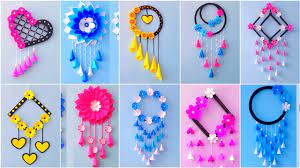Introduction
Wall hangings have been an integral part of human culture and decor for centuries. From ancient tapestries that adorned the walls of grand palaces to contemporary art pieces that grace modern homes, wall hangings have evolved as both functional and aesthetic elements of interior design. In this exploration, we will delve into the history, types, materials, and creative possibilities of wall hangings, demonstrating how they can transform any space into a captivating and personalized sanctuary.
Historical Significance
The history of wall hangings can be traced back to ancient civilizations such as Egypt, Greece, and Persia. These societies utilized textiles, woven fabrics, and intricate designs to embellish their living spaces and communicate stories, beliefs, and cultural heritage. In medieval Europe, tapestries served as both decorative and functional elements, providing insulation and warmth to cold stone walls while depicting scenes of grandeur and historical events. These ornate creations were symbols of prestige and power, adorning the homes of nobles and kings.
Types of Wall Hangings
Modern wall hangings encompass a wide range of styles and forms, allowing individuals to express their unique tastes and personalities. Some popular types include:
Tapestries: Tapestries continue to be a timeless choice, capturing history, mythology, and landscapes through intricate woven designs. They can be made from various materials such as wool, silk, or cotton, and their size can range from small decorative pieces to large, immersive installations.
Macramé: Macramé wall hangings have experienced a resurgence in popularity in recent years. These intricate knots and patterns are created using cords, ropes, and strings, resulting in stunning, textured pieces that bring a bohemian vibe to any space.
Textile Art: Textile art encompasses a wide range of techniques, including quilting, embroidery, and fabric painting. Artists use these methods to create unique, personalized wall hangings that incorporate a variety of textures and materials.
Metal and Wood: Metal or wooden wall hangings can add a touch of industrial or rustic charm to a space. These pieces often feature geometric designs, intricate carvings, or abstract patterns that add depth and dimension to the wall.
Materials and Craftsmanship
The choice of materials significantly influences the appearance and feel of a wall hanging. Natural fibers like cotton, silk, wool, and linen bring warmth and texture, while synthetic materials like acrylic or polyester offer durability and a wider color palette. The craftsmanship involved in creating a wall hanging varies based on the chosen medium. Weaving, knotting, sewing, carving, and painting all require skilled hands and a keen eye for detail. Many artisans also incorporate beads, sequins, or other embellishments to enhance the visual appeal of their creations.
Personalization and Expression
One of the most compelling aspects of wall hangings is their ability to convey personal stories, emotions, and aesthetics. Whether you opt for a ready-made design or commission a custom piece, wall hangings can be tailored to reflect your interests, memories, or aspirations. A family crest or coat of arms, a map of a beloved travel destination, or even an abstract representation of your favorite poem can be transformed into a striking and meaningful wall hanging.
Enhancing Different Spaces
Wall hangings have the remarkable ability to transform the ambiance of various spaces within a home or office. Here are some ideas for incorporating wall hangings into different settings:
Living Room: A large tapestry or a series of smaller textile art pieces can serve as a focal point above a sofa or fireplace, adding color, texture, and visual interest to the room.
Bedroom: Macramé or fabric wall hangings can infuse a cozy and intimate atmosphere into the bedroom. Choose calming colors and designs that reflect your personal style.
Dining Area: Metal or wood wall hangings can bring a touch of sophistication to your dining area. Opt for designs that complement your dining table and decor.
Home Office: In a home office, consider placing a motivational quote or an inspirational artwork as a wall hanging to boost creativity and productivity.
Nursery or Children's Room: Playful and whimsical designs, such as animal-themed tapestries or embroidered storybook characters, can create a stimulating environment for children.
Installation and Display
The placement and arrangement of wall hangings are essential aspects of achieving a cohesive and visually pleasing look. When hanging a single large piece, ensure that it is centered and at eye level for optimal impact. For a gallery-style display, experiment with different arrangements, sizes, and heights to create an engaging and dynamic composition. Command strips, hooks, and decorative rods offer versatile options for securely mounting wall hangings without damaging walls.
Conclusion
Wall hangings have evolved from ancient tapestries that adorned majestic halls to contemporary expressions of art and individuality. With their rich history, diverse styles, and creative possibilities, wall hangings can transform any space into a reflection of your personality and taste. Whether you prefer the intricate craftsmanship of a woven tapestry, the tactile beauty of macramé, or the modern allure of metal and wood, there is a wall hanging waiting to grace your walls and elevate your environment. Embrace the art of wall hangings and embark on a journey of self-expression and design innovation that will leave a lasting impression on your space.


No comments yet